|
Ralf Prehn's (RalfP) Reef Aquarium
Introduction:
There are so many
beauties in the Tanks of the Month ancestral portrait gallery
that I still can't believe mine deserves a place beside them.
Well, it seems to be true, and I am happy and thankful for
being chosen. If for some reason I wake up and discover it
to be a dream, it will have been a really good one that made
my day!
The Way to the Current System:
As a child I kept a freshwater tank
for many years. It's funny, though, while writing this that
I can't remember why I stopped keeping it. Hmmm, maybe other
things kept me busy and it was my parents who said something
like, "Clean it up or shut it down!" I took my time
approaching things this time. About 14 years ago, after a
period of not thinking about tanks for quite awhile, it happened.
I was at the local fish store (a huge place with hundreds
of freshwater tanks), which I visited out of curiosity to
take a look at the place again. I remembered it from my childhood
to be almost like a zoo. What can I say... it had a reef tank
and lots of corals and fish that I had never seen before,
and their employee had enough time to explain things to me.
Following this was a period spent visiting all the local fish
stores and public aquariums with coral reefs that I could
find (there were not many of them in northern Germany), as
well as various attempts to acquire some relevant literature
to gather more information.
 |
|
My older 90-gallon system.
|
Finally, I started my first reef tank. (I think the guy from
the LFS still remembers me from those days.) It had a used,
but too small skimmer and a large trickle-filter like ones
I'd seen in one of the books I had acquired. It took me quite
some time to understand that throwing out the trickle-filter
alone would mean better water quality and lower nitrate levels.
I also learned that buying used equipment is a good idea if
what you're now using is no good and you don't know what you
need; at least it is if you buy things from people who stopped
reefkeeping because they didn't successfully run their tank
with the equipment you're prepared to buy. In the years that
followed I became more and more accustomed to the tank's requirements,
and more information on stony corals became available to me.
Unfortunately, I had a total system crash due to a power outage
caused by an old, defective heater. I then began using a calcium
reactor and performing calcium, alkalinity (and later magnesium)
tests and using bigger skimmers. This laid the groundwork
for keeping my first small-polyped stony corals and gave me
the courage to try a bigger system. I thought that after building
and running my new 90-gallon system (shown above),
I would never, ever have to think about getting a larger tank.
This one was so huge, and the corals were growing so well
and so fast, that I thought it was all I would ever want.
The Current System:
Two years ago, I had the opportunity
to buy a house and renovate it from scratch. Looking at my
crowded, way too small tank, I had no choice: I desperately
needed a much bigger tank! And, the new one would be so huge
that I would never, ever have to think about getting a bigger
one.
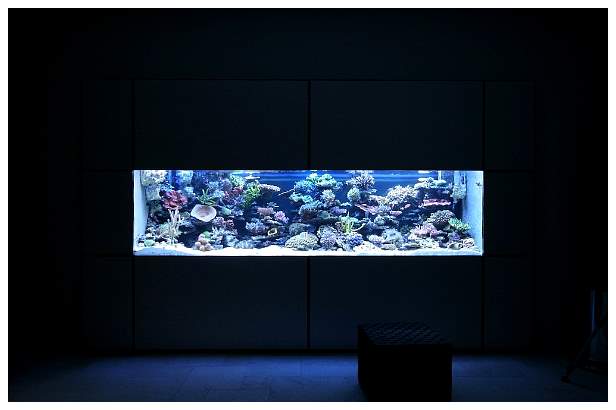 |
In my opinion, all the technical equipment should be unobtrusive,
hidden and quiet (at least if not used to make sound), and
simply should work. There was no choice, then; the new system
would have to be an in-wall design. Fortunately, the living
room was flanked by a relatively small room, a former study
with no cellar directly under it and a solid concrete floor.
The initial obstacles such as, "there is no water plumbed
into this room," "the door is on the wrong wall,"
"but there is under-floor heating in this area"
and "there's not enough electrical power here" were
subject to immediate change. What was discussed more extensively
was the question, "How big can it be and still leave
enough room for the equipment, while looking harmonious from
the living room?" Discussing this with the planners,
who helped renovate the house, and Michael, who got the job
of building the tank, the answer was found, and it's been
up and running for about a year now.
The Tank Itself:
The tank is approximately 9.8' x 4.3'
x 2.8', which means it contains about 870 US gallons (roughly
3 meters x 1.3 meters x .85 meters = about 3300 liters). The
front glass is made of LSG (laminated sheet glass) for security
reasons. The LSG is made of OptiWhite glass with a reduced
iron oxide content, which does not have the green color typical
of normal glass. All siliconed joints are covered with additional
glass bars to keep the critters away from the joints and to
hopefully ensure the tank is leak-proof for many years to
come. The stand is made of V2A high-grade stainless steel
and was screwed into the concrete prior to pouring the cast
plaster flooring. A 2" waterproof birch multiplex board,
as well as some foam material, is glued in place under the
tank to help distribute the load of the tank. The tank's cladding
was made by the carpenter who did most of the woodwork in
my new home. The color and style fit perfectly with the rest
of the room, and the brushed steel shadow-gap around the panels
is found in other locations of the house such as around the
fireplace, etc. Front access to the tank is provided by the
two big panels above it, which can be lifted with the aid
of a pressure-cylinder (photo above right). Click here
for a slideshow of the tank's construction.
- In-wall OptiWhite glass tank - 870 gallons, 9.8' x 4.3'
x 2.8'
- Stand: high-grade stainless steel screwed to concrete
- Front access by opening panels above the tank
- Powder-coated aluminum frame on tank for stabilization
The tank's back glass is covered with 3mm thick black PVC
foam from the local hardware store, which is sold for various
handicraft purposes. I wanted to be able to look into the
back of the tank, behind the rocks, to search for lost fish,
critters, etc., because being unable to simply take a lamp
and look behind the rocks made me nervous (see photo below).
As these panels are made of PVC foam, they can be easily cut
to size. I have three of these plates behind the tank, and
secured a "U-shaped" bar of PVC using PVC glue to
the top of each with the "U" opening pointing down;
the "U-bar" is made of two "L-bars" glued
together. With this configuration I can hang them onto the
back of the tank or take them away as needed. Their dark blue
color is achieved by using a self-adhering contact paper,
called D-C-Fix,
in a "marine-blue" color, a material that's typically
used to spruce up old furniture.
|
A view from behind the tank with the panels removed.
|
Let There be Light!
Directly connected to my desire for
a stony coral dominated tank is the need for a lot of light.
A light hood for the large number of lamps would have to be
temperature resistant and air/heat permeable. It's also important
for it to be moveable, because I cannot play around with all
those lamps for half an hour just to be able to reach into
the tank. Unfortunately, the room behind the tank has an angular
roof, so the usual design of a hood that slid away on tracks
would not work. Well, the height of one side is constrained
by the slanted wall behind it so we decided on a high-grade
stainless steel hood with hinges on that side. Thinking about
something saltwater resistant to lift the hood on the other
side, we used a winch
from a sailboat supplier for that job. It actually works quite
well. I wanted to have a cold-blue light but also enough PAR
to reach the substrate, where I intended to keep some stony
corals. We decided to use a T5 / metal halide (HQI) combination.
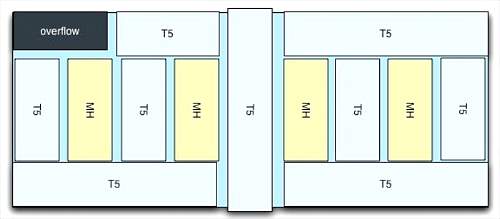 |
- Four
400-watt metal halide (HQI) Giesemann System 400s (MegaChrome
12,500K)
- Four
Lumimaster (Osram ballast) T5s (two 54-watt Aquascience
special 15,000K and two 54-watt Osram Blue bulbs)
- Five
Lumimaster (Osram ballast) T5s (two 24-watt Aquascience
special 15,000K and two 24-watt Osram Blue bulbs)
The above configuration provides nearly 3000 watts at "high
noon," and they're switched in five groups, turned on
in this order and off in the reverse order:
-
The outer Osram Blue set (six 54-watt and two 24-watt = 372
watts)
- The inner Osram Blue set (two 54-watt and eight 24-watt
= 300 watts)
- The outer 15,000 K Aquascience set (six 54-watt and two
24-watt = 372 watts)
- The inner 15,000 K Aquascience set (two 54-watt and eight
24-watt = 300 watts)
- HQI 12,500 K metal halides (four 400-watt = 1600 watts)
All of this lighting creates lots of warm, damp air in the
room the tank is in, so there had to be a way to keep this
heat and humidity under control.
Temperature and Humidity Control:
Thinking about the relatively small
tank room that's occupied mainly by the tank itself and the
sump, and heated by the light hood, the decision to cool and
heat the whole room instead of the tank was obvious. A Toshiba
split-level air conditioner was installed in the room, guiding
its air outlet just above the tank directly into the light
hood. Keeping the room at a maximum temperature of 73°
F (23° C), the tank barely reaches 81° F (27°
C). This past winter I discovered that my air conditioning
stops working at 32° F (0° C). That's generally not
a problem regarding the room's temperature, but if the air
conditioner is also the solution for the humid air created
by the tank, I'm in trouble. I recently installed a Stiebel
Eltron DL 13 fan (photo right) to vent the air to the
outside. It has a cross flow heat exchanger which claims to
exchange air while keeping 80-90% of the warmth inside. An
additional fan runs in the wall between the tank room and
the winter garden. This fan produces low pressure in the tank
room and ensures that the damp air is not creeping into the
living room by moving the air in a different direction. The
result is that the living room typically has less than 50%
relative humidity.
The Fish or Tank Room and Water Storage:
Skid-proof tiles on the floor and
along the walls help keep the tank room clean and allow spilled
water to be easily removed. There is a sink in one corner
and a small table where my microscope and a balance are stored.
A reverse osmosis filter with automatic rinsing and a mixed-bed
ion-exchanger are also located here. This area also contains
several dosing pumps for different purposes that are screwed
to the wall. The electricity for this room consists of three
independent circuits, each with its own GFCI (ground fault
circuit interrupter), so it's highly unlikely that all equipment
will stop working at the same time. As additional protection,
two of the later mentioned Tunze circulation pumps are each
connected to their own uninterruptible power supply unit (2200
VA).
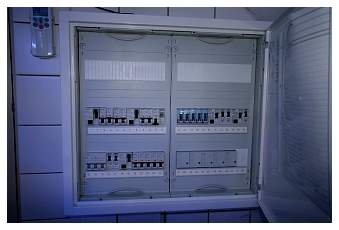 |
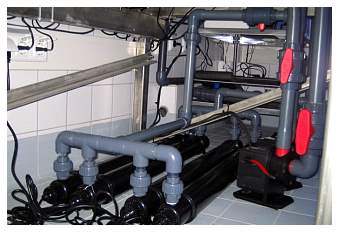 |
As this room with all of its described contents is already
quite crowded, I created another small room in the cellar
(photo below) as my water storage and saltwater mix-up
room. Some core-drillings allowed the plumbing connection
between the two rooms. Two 400-gallon connected containers
hold the RO/DI water produced by the reverse osmosis/exchanger.
The level-probe of the osmosis filter in the tank room sits
here. The containers are connected with PVC pipes and three-way
valves to a 50-gallon rain barrel, which I use for water mix-up
with a pump and a pipe in the tank room. The pump can be switched
on/off from both rooms. Next to the rain barrel is a 125-gallon
container for storing mixed-up saltwater made with Tropic
Marin salt. An additional pump in this container is connected
to the sump upstairs. It's switched on/off upstairs so that
I can see what happens to the tank and sump when pumping in
new saltwater. There is one major thing in the tank room besides
the tank…
The Sump:
The 120-gallon glass sump is divided
into two equal portions. One houses a large Bubble King skimmer,
the return pump, a filter sock, the measuring probes for the
IKS-Aquastar and a level controller connected to a dosing
pump for top-off. The Rowa fluidized bed filter is empty at
the moment and is used for different absorbers/media as needed,
such as ROWA®phos and carbon. The second partitioned
area is lit with two T8 bulbs that run only at night, and
is populated mainly with Caulerpa and some coral fragments.
It also houses a bubble-tip anemone which I rescued from a
friend's dying, freshly started tank that I helped set up.
The UV-sterilizer, housing four 34-watt bulbs, is not connected
here; it's on a bypass off one of the external circulation
pumps.
Water Movement & Parameters:
Before introducing my friends, the
animals, in this setup I'll drop some words about the water
movement and parameters. I am happy with the water movement
for now, but as I know from previous reef systems, it'll decrease
a lot as the corals continue to grow over the years. Currently,
the tank's circulation is provided by:
- A
Red Dragon return pump pushing about 3,700 gal/h (14,000
l/h), 30% of which is diverted into the Caulerpa
filter.
- Two
external Red Dragon pumps, each producing about 3,200 gal/h
(12,000 l/h).
- Two
Tunze waveboxes with "night mode."
- Two
Tunze Streams, producing about 5,300 gal/h (20,000 l/h)
each, with "night mode" capability that are located
on the right and left sides of the tank, pointing toward
one another. They run alternately with the right one set
at 100% output and the left one at around 30% output, because
the output from the Red Dragons is also coming from the
left.
- Two
Tunze Streams at about 3,200 gal/h (12,000 l/h) each, with
"night mode" capability that are located near
the middle of the tank's back glass and hidden behind a
reef-pylon; one points 45° to the right and the other
points 45° to the left. They run alternately at a maximum
output of 40%.
All of this provides up to 22,000 gallons/hour, which is
about 25 times turnover, and this seems to be sufficient for
the current reef structure.
Water
Parameters:
|
|
NO3:
< 1 ppm (TropicMarin test kit) |
|
|
PO4:
< 0.03 ppm (Merck-Deltec test kit) |
|
|
Ca:
420 ppm (TropicMarin test kit) |
|
|
Mg:
1340 ppm (TropicMarin test kit) |
|
|
SiO3:
not
detectable (Salifert test kit) |
|
|
Alk:
8 dKH (TropicMarin test kit) |
|
|
Salinity:
3.4
% (refractometer) |
|
|
pH:
~8.1
(IKS-electronic probe) |
|
|
|
Using strong skimming, 98% live rock for decoration, a moderate
fish count and Caulerpa in the sump, I find no issue
with nutrient overabundance in the system. I perform a 50-gallon
(one rain barrel) water change each week and use about one
pound of activated carbon every three months for three days.
Calcium, magnesium and alkalinity are kept at optimum levels
using a modified version of the "balling" method,
which is basically adding diluted chemicals to the water.
I use peristaltic dosing pumps for this task, which allows
me to keep the parameters where I want them. This method replaces
the previously used calcium reactor and magnesium additions.
Having the above mentioned 11 channel Grotech dosing station,
I also add a strontium/barium solution ("grow pusher"),
PVP-Iodine and QFI-elements (at 10% of recommended dosage)
automatically.
I use the 11 channels for:
| |
Channel 1 - CaCl2 solution for Ca
support
Channel 2 - MgCl2 solution for Mg
support
Channels 3+4 - NaHCO3 solution for
KH support
Channels 5+6 - NaCl-free salt solution to prevent
ion displacements because Ca/Mg/NaHCO3 supplementation
also adds NaCl, which has to be compensated for
Channels 7+8 - used for removal of tank water,
which is then replaced with RO/DI water for top-off
by the level controller because the above additions
raise the salt concentration
Channel 9 - Strontium/barium solution
Channel 10 - Iodine solution
Channel 11 - Trace elements from QFI
|
|
It's Alive!
The reef is composed of 770 pounds
(350 kg) of class-A live rock, pre-cycled at the importer
and driven overnight to its current location. Live sand (320
pounds, 145 kg) gives the tank a nice white substrate. When
initially setting up the system, half of the water was collected
over several weeks from my old system by performing large
water changes; the other half was mixed up some weeks prior
to usage.
The live rock and sand bed are kept clean by an assortment
of critters:
- Fish:
one Amblygobius phalaena (sand digging goby), three
surgeonfishes, one foxface (described later)
-
Starfish: three Archaster angulatus, which keep
the sand fluffy by digging through it
-
Sea cucumbers: one Holothuria atra (black), one
Holothuria edulis (pink) - dirty sand in, clean sand
out
-
Snails: one Dolabella auricularia (sea-bunny)
200 small Nerita sp. and Astraea sp. initially
(Astraea propagating themselves, stable population)
>50 Stomatella sp. - hitchhikers on the live rock
(propagating themselves, stable population)
>50 Morula sp. - hitchhikers on the live rock
(propagating themselves, stable population)
-
Hermits: 200 initially, mainly Calcinus elegans
(blue/black) and Paguristes cadenati (red), one Ciliopagurus
strigatus (red/yellow) - spawning, seeing larvae nearly
every night, but don't think they'll survive, probably eaten
by the corals
To close the list let me mention the following invertebrates:
- One
Alpheus frontalis (Pistol shrimp, hitchhiker on the
live rock)
- Five
Lysmata debelius (Fire shrimp, clean the fish)
- Two
Tridacna maxima, two Tridacna derasa (one
about 15" long), and one Tridacna gigas
Corals:
I manually feed the corals on occasion
(every other day or so) with a phytoplankton substitute by
Fauna Marin and a zooplankton substitute by Tropic Marin.
Additionally, the tank is dosed with amino acids. While I'm
able to determine what an Acropora is and what's a
Montipora, etc., I am not sure I'm able to precisely
name them all scientifically, so please just take a look at
the pictures and assume that these are my best guesses at
their correct names in the lists that follow.
The lists are sorted by the number of species kept.
Small-polyp Stony Corals
- Acropora spp. - in many shapes and colors (table,
bush, staghorn, etc.)
- Montipora digitata and encrusting Montipora
of various colors
- Porites spp. - some 3" diameter came with
the live rock; some are 6" connecting the reef pylons
(yellow, green, reddish) - 1/2" spots of greenish and
yellow ones show up here and there... don't know where they're
from
- Seriatopora hystrix (pink), S. caliendrum
(brown), S. stellata (green)
- Pocillopora damicornis (pink)
- Stylophora pistillata (greenish, others pink)
- Merulina spp. (green, yellow)
- Pavona sp. - Cactus coral (green)
Large-polyp Stony Corals
- Favia/Favites/Montastrea (assorted
green and one orange)
- Hydnophora grandis, H. pilosa, H. rigida
- Two 12" Catalaphyllia jardinei (greenish)
- Galaxea sp. (green)
- Alveopora tizardi (green)
- Acanthastrea sp. (green/red)
- Blastomussa merletti (red/green)
- Turbinaria sp.
- Caulastrea sp. (green)
- Cycloseris patelliformis
- Ctenactis echinata
- Echinophyllia sp.
- Cyphastrea chalcidium
(yellow, good at connecting rocks)
- Cynarina sp. (green)
- Scolymia sp. (green)
- 19" Brain coral (brown/light green)
|
Soft Corals
- Sinularia sp. (greenish)
- Ricordea sp.
- Briareum sp. (green)
- Gorgonia ventalina
- Plexaura flexuosa
- Pseudopterogorgia americana
|
The sea fan is seen here in the upper left corner.
|
Fish:
I trust in pushing the balance between
fish and corals slightly to the coral side (meaning fewer
fish than I could possibly keep). Feeding the fish shouldn't
raise NO3 and PO4, nor should they die
from starvation. Having Anthias in the tank, I am feeding
five times a day - three times with frozen Mysis and
Artemia and two times with pellets dispensed by an
automatic feeder. If I am away from home for a short time,
they're fed four times/day by the automatic feeder.
The following fishes are living here:
- Adult
Siganus magnificus (Magnificent rabbitfish)- I nearly
forgot that he has poisonous fins (hurts really badly for
days, I was told). He never did anything to me, but it was
a strange feeling remembering that his spines are poisonous
while having my face in the tank wearing a diving mask to
place corals and seeing him looking into my eyes!
- Nearly
adult Chelmon rostratus (Copperband butterflyfish
with no interest in Aiptasia at all).
- Adult
colored Acanthurus pyroferus (Chocolate surgeonfish).
- Nearly
adult Acanthurus leucosternon (Powder Blue surgeonfish).
- Adult
Ctenochaetus strigosus (a Kole tang with a really
bad character. It's a good thing that he'll remain small).
- Five
Pseudocheilinus hexataenia (Sixline wrasses to clean
unwanted parasites from the corals), spawning once a week,
the Anthias love that.
- 15
Pseudanthias dispar (2 males & one in the process
of changing to a male... I think the group is already too
big for one male to keep his women under control).
- One
Amblygobius phalaena (a Dragon goby; cleans the sand).
Initially there were two, but the Kole tang killed one (took
3 days).
Subject to Change/the Future:
The system itself is running sufficiently.
I can't say what I would have done differently given my experiences
to date. Maybe it's too early to judge the long-term results
after only a year. The sump could have been divided into different
partitions instead of placing external filters with bypasses.
As described earlier, dealing with the humid air was already
subject to change, as well as some minor issues with the RO/DI
water (I measure TDS now before and after the ion exchanger
to know when it is worn out) and other minor issues most aquarists
change from time to time. Regarding the animals, I wouldn't
have added the Kole tang - it seems I'm the only one who didn't
know about their aggressive character.
Future extensions/additions are already being planned. As
the corals start to touch each other, I am building a small
coral fragment tank above the sump's algae partition that
will be lit with T5 bulbs. Thirty percent of the water from
the return pump is already redirected to the sump's algae
partition, so I can simply add a pipe to divert the output
to the fragment tank first and from there back to the algae
partition.
As I consider the sump's algae partition not being the best
place for the green bubble-tip anemone that I rescued, I'm
thinking about building a small tank housing only anemones
and clownfish, and possibly trying to breed them. Well, this
still needs some more thought. When breeding clownfish, and
given that I have plenty of zooplankton here... why not try
breeding Pseudochromis fridmani? I read an interesting
article about it. Well, that needs even more thought. Having
phyto- and zooplankton here, what about building a "Kreisel"
tank with dim blue light in the basement and keeping jellyfish?
Well, that's even further in the future and needs more thinking
and learning, but that's what reefkeeping means to me. There
is no end to learning, trying to optimize the environment
for the animals while still having fun looking at them and
sharing the knowledge.
Thanks and Credits:
I did not build this system alone,
and did not consider doing so to be wise. If you want something
to be done in the best possible way, it's possibly not you
who should do all of the work. The biggest, most important
help was provided by:
Michael Mrutzek from Mrutzek's Meeresaquaristik, a longtime
friend of mine, who gave me advice, did some of the planning
and supported me with his active assistance. Michael is a
well-known aquarist on Germany's reef scene, having operated
a reef-dedicated local fish store for more than 20 years now.
Claude Schumacher - you might know him from his company, Fauna
Marin - also did some of the system's planning and we ordered
the tank from him. Ralf Geis glued the tank in its current
position... Man, what a craftsman! Many thanks are due to
Hennings & Boern, the guys who helped plan the home renovation,
and who had some tremendous ideas to make the tank blend well
with the rest of the house's décor. The high-grade
stainless steel stand, cladding and air conditioning were
all done by other companies, and they did a fantastic job.
I'd also like to thank my wife, who prevented me from going
mad during all of the construction and for not saying one
negative word about it! Also, many thanks to Reefkeeping
Magazine and Reef Central for giving me the chance to
share my setup with you. Special thanks to the editorial staff
at Reefkeeping Magazine, who did a great job in editing
this article and in finding the right words and expressions
to make the article more readable (German is my native language).
And last, but not least, thank you, dear reader, for actually
being the one I am sharing all this information with.
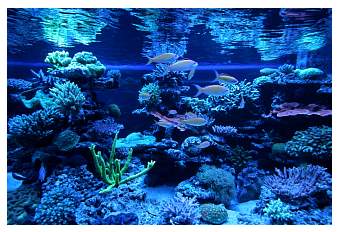 |
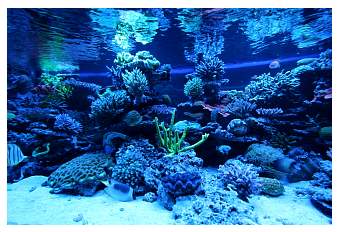 |
For more information, visit Ralf's website.
Feel free to comment
or ask questions about my tank in the Tank of the Month thread
on Reef Central.
|
If you'd like
to nominate a tank for Tank of the Month, click here
or use the button to the right.
|
 |
|

